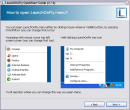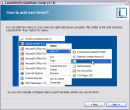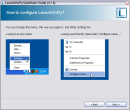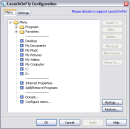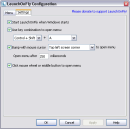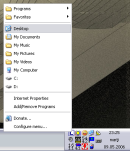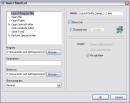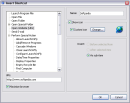Many are the occasions when I'm too lazy to minimize all windows and then double click on the My computer icon on the Desktop, just to enter Windows Explorer.
Of course, there's the old Win+E combination that does the trick, or the Microsoft Windows XP Start menu that features a My computer shortcut. But with all the applications out there, I'd need to memorize too many keyboard shortcut combinations.
So I've started to search for a program that does this for me. And I was lucky enough to find a little piece of software called LaunchOnFly, created by Artur Sits.
What it does
This is like a smaller brother of your classic Start Menu, but more powerful. LaunchOnFly is easy to install, and it doesn't take long for you to get used to what it has to offer. Basically, it copies the behavior of the Start menu, and enhances it so you can have faster access to your computer's resources.
It has a vertical structure that you can fragment using line separators. You can easily configure it so that you get a customized look. Thus, you'll end up having all the shortcuts you need in one menu that pops up when you enter ONE key combination.
What I like about LaunchOnFly is that you can set multiple key combinations or mouse gestures to open the menu.
You have the option of opening it by moving the mouse in different areas of the screen. So, should you choose to select "bump the mouse in the bottom left corner to open menu", this would be just like teasing the old Start button and saying "Look, no click necessary!".
Working with the program
Regardless on how you choose to open the menu, it will pop up wherever the mouse is placed.
Moving on to the configuration options, I've noticed that there are three main types of items you can place in the LaunchOnFly menu: Shortcuts, Folders and Separators.
The main concept of the program being, of course, THE SHORTCUT, you can use the folders and separators that you insert to organize your shortcuts.
When adding a folder to the menu, you have the option of changing the icon; this way, things get colored, and can catch your attention easier. If you want to get hierarchical, you can add folders and sub-folders, and so on, but the more "subs" you insert, the less of a shortcut you get.
As for the shortcuts that you can place in the menu, you have plenty of options, and you can move them up and down, so that you get the layout that you want.
You can easily add basic Windows Explorer shortcuts, and URL shortcuts. When first installing the application, there is a Favorites folder already created, so all you have to do is manage it so that it suits your browsing needs.
You can add a shortcut to open a file, or launch a program. A feature that I like is the fact that you can enter parameters for the program. So, if there are multiple persons that use a certain application, you can insert several shortcuts for the same application, each of them customized with a set of specific parameters (e.g. username, window state, field values, and so on).
You can open a set of special folders, such as Control Panel, Desktop, My Computer, Network, Neighborhood, My Documents, Printers and the Recycle Bin.
Also, there is a series of special actions that can be assigned to a shortcut. This is the most important feature of the program, with a long action list for you to choose from. I really like the fact that you can add a shortcut for the "Shutdown computer" action (or any other major power management function), without having to go through the "Shut Down Windows dialog" (although you have this option too).
In order to open the menu you can assign up to three combinations at a time: clicking middle mouse button, or scroll, a key combination and bumping the mouse in the screen corners or borders. You can set a time delay in order not to have the menu show up all the time due to accidentally touching a corner or a border of the screen with the mouse.
I've noticed that there are no keyboard shortcuts that you can set for the items in the menu. You can set up to three key shortcuts that open the menu at the same time, and from there on, you either have to click on the item that you want, or move your way around using the arrow keys.
Another limitation is that you can only organize your shortcuts vertically, placing them one under the other. But you can get over this minor inconvenience by using sub-folders (for shortcuts in the same category) and separators (for shortcuts in different categories).
A nice feature is the fact that you can add items to the menu, not only from the configuration panel, but also, by using the Send to option that Windows provides.
All you have to do is imagine the possibilities, and this little tool will help you explore them all.
The Good
The program is free to use, and it offers a great deal of features that you'll surely find useful.
The Bad
It's hard for me to find something bad about LaunchOnFly, but I guess I can count the lack of key shortcuts for the items in the menu as one. The main purpose of the program is replacing the Start menu, so this drawback is meaningless.
The Truth
I found this little tool to be very useful, and if it had the option of replacing the Start menu permanently, it would have it all.
Check out the screenshots below, click to enlarge.
 14 DAY TRIAL //
14 DAY TRIAL // 